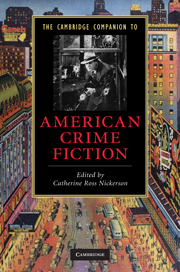Book contents
- Frontmatter
- 1 Introduction: The satisfactions of murder
- 2 Early American crime writing
- 3 Poe and the origins of detective fiction
- 4 Women writers before 1960
- 5 The hard-boiled novel
- 6 The American roman noir
- 7 Teenage detectives and teenage delinquents
- 8 American spy fiction
- 9 The police procedural in literature and on television
- 10 Mafia stories and the American gangster
- 11 True crime
- 12 Race and American crime fiction
- 13 Feminist crime fiction
- 14 Crime in postmodernist fiction
- Guide to reading
- Index
14 - Crime in postmodernist fiction
Published online by Cambridge University Press: 28 September 2010
- Frontmatter
- 1 Introduction: The satisfactions of murder
- 2 Early American crime writing
- 3 Poe and the origins of detective fiction
- 4 Women writers before 1960
- 5 The hard-boiled novel
- 6 The American roman noir
- 7 Teenage detectives and teenage delinquents
- 8 American spy fiction
- 9 The police procedural in literature and on television
- 10 Mafia stories and the American gangster
- 11 True crime
- 12 Race and American crime fiction
- 13 Feminist crime fiction
- 14 Crime in postmodernist fiction
- Guide to reading
- Index
Summary
“The cheaper the crook, the gaudier the patter, eh?” Sam Spade remarks in The Maltese Falcon. “Gaudy” describes something excessively garish or showy, and “gaudier,” of course, even more so; although “patter” connotes the smooth, practiced speech used by hucksters to attract customers or by magicians to distract audiences, its primary meaning, according to the Oxford English Dictionary, is “thieves' lingo.” This word choice suggests that Spade - a modernist private eye attuned to social façades - thinks of being a crook as a performance, even a crudely exaggerated one.
For postmodernist novelists, too, crime is largely a matter of appearances. Indeed, the generic elements linked to solving the mystery in a detective story - observing ambiguous signs and constructing a possible narrative from them - characterize postmodernist fiction in general. Some novels emphasize these hermeneutic and epistemological aspects so markedly that they have been labeled “anti-detective fiction,” “postmodern mysteries,” “deconstructive mysteries,” or “metaphysical detective stories.” Investigation is so overdetermined, one might say, that in some instances - like William Hjortsberg's novel Falling Angel or Christopher Nolan's film Memento - the private eye himself turns out to be the criminal he pursues.
- Type
- Chapter
- Information
- The Cambridge Companion to American Crime Fiction , pp. 163 - 177Publisher: Cambridge University PressPrint publication year: 2010
- 3
- Cited by

